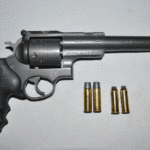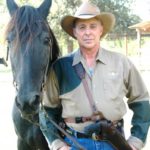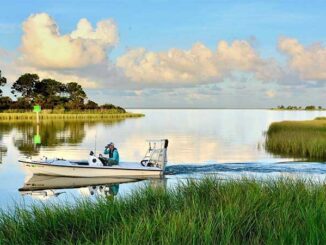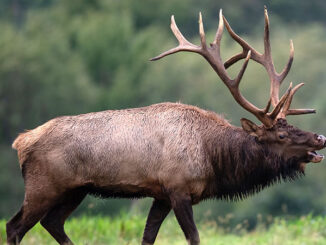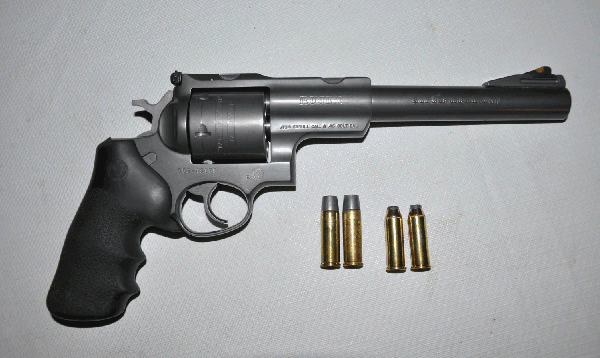
Hunting hard-to-kill pigs is no time to wimp out
I was sitting on an East Texas pipeline, cradling my 7 1/2-inch Ruger Super Redhawk in my lap, watching a pile of corn that had been scattered about the area and trampled with hundreds of hog tracks.
My hand cannon was stuffed with 335-grain hard-cast bullets in .454 Casull, a potent enough load in itself, but this went the extra step. These rounds were manufactured by Cor-Bon — a company that found its niche in the ammunition market by producing ammo that pushed the envelope.If it says Cor-Bon, the most-used adjective is “hot.”
I had killed a smaller hog the day before, the bullet driving completely through the 75-pound sow. And I had “partnered” on another boar that had run by me, allowing me to put one in the heart/lung area — before it ran under a tree where Dick Williams, a noted gun writer, performed one of the more incredible feats I have ever seen with a handgun.
Standing on one limb, hanging from another with his left hand, Dick had fired three times as the hog ran under him, driving three shots into the boar’s back from the shoulder area to the rump.
Dick was using another Super Redhawk, this one loaded with Cor-Bon .44 Magnum ammo.
None of these hit exactly on the spine, and the hog ran up in the woods where he died.
Another writer, the one that got the hog up and moving, had shot it in the left front hoof and the left ear. The pig was sizzling when he ran by me.
But I wanted a large one I could claim all by myself, and I wasn’t looking forward to shooting the Redhawk again.
I shoot a lot of handguns, and don’t consider myself recoil sensitive, but these Cor-Bon loads HURT.
Pushing a 335-grain projectile out of a 53-ounce handgun to 1,600 feet per second, the gun was bound to push back. The recoil impulse, with 1,905 foot/pounds of energy, was so fierce that I was thrilled to find out someone had taken the time to tune in the Crimson Trace Laser Grip mounted on the gun.
I had fired two cylinders full of six rounds each, and my wrist HURT. Thank the shooting gods the doggone sights and laser all hit in the same place at the right distance.
Down the pipeline, a gun roared. It was getting on towards twilight and I was seeing nothing, so I walked down the line to see Travis Noteboom, then a senior marketing rep with Crimson Trace, standing over a 150-pound sow.
Travis had dropped her with one shot to the rear of the ear from about 25 yards.
I knew he could shoot; I had seen him wield a Smith & Wesson revolver in an impromptu match at a writers’ conference, but this was impressive — and with a .44 Magnum.
The sow, as they say, was “DRT” — dead right there.
I can probably shoot that good, but I get excited and shoot “minute-of-hog,” hurriedly aiming for the largest target, the heart/lung area.
Noteboom had taken his time, carefully aimed at the neck behind the ear, and there was no tracking, no blood trail, no worries, mate.
That night, after seeing the results of Noteboom’s exceptional shooting skills, I traded my hard-charging .454 Casull for a more-pleasant-shooting .44 Magnum.
The weight of the Rugers we were shooting reduced the recoil of the still-hot-for-caliber .44 Magnums to something more palatable and civilized. My right wrist just could not take the abuse any longer.
Dick Casull had concocted his namesake cartridge by extending the length of the .45 Colt, although it is thicker in the head and made for use with small rifle primers. It is a bear of a cartridge, and at the time supplanted the .44 Magnum as the most-powerful production handgun in the world.
Since the cartridge is the same diameter, the revolvers that fire it will also shoot .45 Colt (sometimes incorrectly called .45 Long Colt.)
The hunt was sponsored by Crimson Trace; the handguns were supplied by Ruger, and the ammo by Cor-Bon — which had shipped lots of .454 Casull and .44 Magnum but no .45 Colt. I couldn’t take the beating any more of their version of Dick Casull’s bullet, so I wussied out.
I would regret this the very next morning.
Getting up before daylight, we met our transplanted Cajun guide, Rusty, at the lodge for coffee and biscuits. We saw lots of hogs roaming the fields at daylight, and I thought we might get a shot at one on this, our last morning.
Another writer friend had killed a very small hog, but had not been able to get a shot on a larger one, so I asked Rusty to take us out. It was the last morning, and everyone else was sleeping in, planning on leaving around lunchtime to make it to the Dallas/Ft. Worth airport.
We rounded a corner of woods, and there was a big hog standing maybe 50 feet from the edge of the woods, feeding on acorns. It was a perfect setup.
Rusty maneuvered the electric cart so we were hidden by the large oak tree with a round circle of privet growing around its base. I whispered to my buddy to walk straight up to the privet, get his gun ready, step to the side and shoot the hog from a distance of maybe 40 feet.
Hogs don’t have great eyesight, but when a man steps into view from a distance of 40 feet and fires a .44 Magnum, they hear and see enough.
My buddy missed, and instead of running into the woods, a mere 50 feet away, the hog whirled and ran diagonally across the field from us, making high speed.
As he safely cleared my friend, I fired a shot at the hog, and missed.
Aggravated, I settled down, swung through the body of the hog, and as the sights passed his snout I pulled the trigger, and, the hog stumbled.
“I think you hit that hog!” Rusty exclaimed. “He almost nosed into the dirt!”
Pulling out my Bushnell laser rangefinder, we lased the spot where the hog had run into the woods, just past where he had stumbled. The rangefinder said 60 yards.
I was excited. We were about to go tracking a large hog on which I had performed one of the great shots of my lifetime — with two witnesses.
We rolled up to where we thought I had hit the hog and found a splattering of blood. There was a blood trail leading into the woods, and we followed it.
We went in only 20 yards or so, easily following the blood spoor, when the hog stood up broadside to us, only about 50 feet away — an easy shot.
Except I got excited, and once again took a “minute-of-hog” shot — and this time I was using the .44 Magnum.
I hit him hard, right in the center of the body. And we spent the morning tracking, for two hours, until we had to break off and get back to the lodge to leave for the airport.
I was sick. Sick over losing the hog after such a beautiful shot and leaving a wounded animal in the woods. But hogs are incredibly hard to bring down, and this one — shot twice — just did not go down again where we could find it.
Rusty promised to go back and search again, and I’m sure he did, but he never called to tell me he had found my hog, and to this day I can blame losing the hog over “wussying out” and replacing the .454 Casull with the “lighter” .44 Magnum.
